Trends in the Social Security and Supplemental Security Income Disability Programs
Changes in Incentives Influencing Program Size
Introduction
Empirical evidence suggests that the incentives to seek Disability Insurance and Supplemental Security Income are positively related to the size of the benefit. The relationship between the real value of earnings and benefits or payments is one factor that determines the attractiveness of the program.
As will be shown in this section, the increase in wages lagged behind the increase in prices through much of the 1970s and 1980s, and individuals in the disability programs gained relative to those in the workforce. In such periods, the promise that future Social Security benefits will be adjusted for inflation can increase incentives to seek benefits.
Furthermore, disparity in the distribution of income has increased, with low earners realizing proportionately smaller wage gains than high earners. Because the formula used to calculate Social Security benefits is indexed to the average growth in wages, systematic disparities in earnings growth will result in altered incentives. A slower rate of wage growth for low earners than for high earners (that is, widening disparity in the distribution of earned income), as has been reported in recent years, coupled with SSA's calculation of average indexed monthly earnings (AIME), which uses an indexing formula based on average wages, have been hypothesized to result in higher replacement rates and increased incentives among lower earners to apply for benefits.
This section focuses on several changes that may have altered program incentives and program size: indexation of benefits, changes in the replacement rate and maximum SSI cash payments, changes in the level of earnings considered to be substantial gainful activity, and economic conditions as measured by the unemployment rate.
Changes in Prices and Wages
Through much of the 1970s, wages did not grow any faster than prices, and in the late 1970s and early 1980s the increase in wages lagged behind the increase in prices. Individuals in SSA's disability programs gained relative to those in the workforce. The effect has been greater on low earners, and the decline in real wages may be continuing for this group.
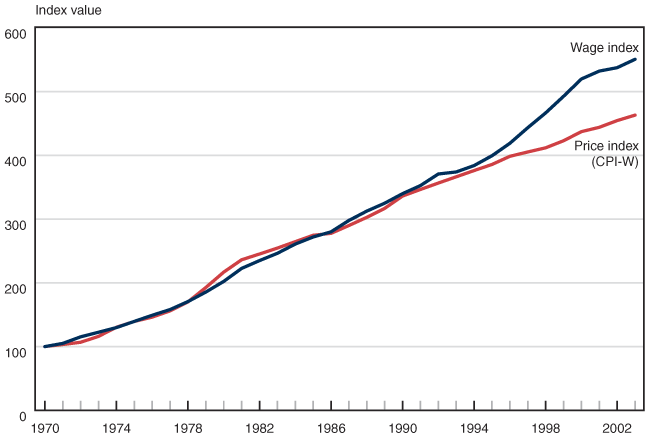
| Year | Wage index | Price index (CPI-W) |
|---|---|---|
| 1970 | 100.00 | 100.00 |
| 1971 | 105.02 | 103.27 |
| 1972 | 115.32 | 106.78 |
| 1973 | 122.53 | 116.08 |
| 1974 | 129.82 | 130.40 |
| 1975 | 139.52 | 139.45 |
| 1976 | 149.15 | 146.23 |
| 1977 | 158.08 | 156.03 |
| 1978 | 170.64 | 170.10 |
| 1979 | 185.56 | 192.71 |
| 1980 | 202.28 | 216.83 |
| 1981 | 222.64 | 236.18 |
| 1982 | 234.90 | 245.23 |
| 1983 | 246.34 | 254.52 |
| 1984 | 260.82 | 264.57 |
| 1985 | 271.93 | 274.62 |
| 1986 | 280.01 | 277.64 |
| 1987 | 297.86 | 289.95 |
| 1988 | 312.53 | 302.76 |
| 1989 | 324.91 | 316.83 |
| 1990 | 339.92 | 336.18 |
| 1991 | 352.58 | 346.48 |
| 1992 | 370.75 | 356.53 |
| 1993 | 373.94 | 366.33 |
| 1994 | 383.97 | 376.13 |
| 1995 | 399.36 | 385.68 |
| 1996 | 418.90 | 398.49 |
| 1997 | 443.34 | 405.28 |
| 1998 | 466.54 | 411.81 |
| 1999 | 492.54 | 422.86 |
| 2000 | 519.78 | 437.19 |
| 2001 | 532.18 | 443.97 |
| 2002 | 537.52 | 454.52 |
| 2003 | 550.66 | 463.07 |
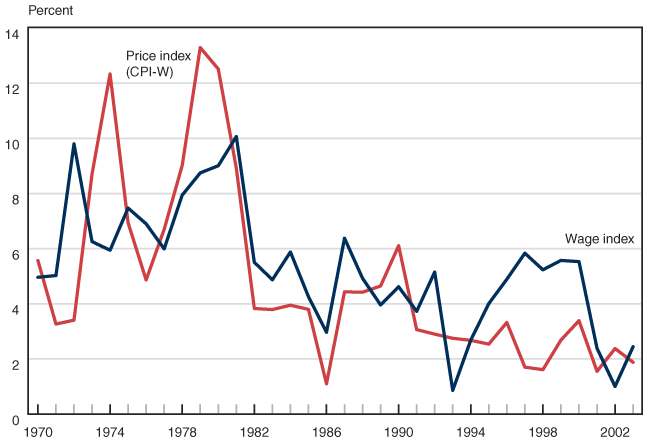
| Year | Wage index | Price index (CPI-W) |
|---|---|---|
| 1970 | 4.96 | 5.57 |
| 1971 | 5.02 | 3.27 |
| 1972 | 9.80 | 3.41 |
| 1973 | 6.26 | 8.71 |
| 1974 | 5.94 | 12.34 |
| 1975 | 7.47 | 6.94 |
| 1976 | 6.90 | 4.86 |
| 1977 | 5.99 | 6.70 |
| 1978 | 7.94 | 9.02 |
| 1979 | 8.75 | 13.29 |
| 1980 | 9.01 | 12.52 |
| 1981 | 10.07 | 8.92 |
| 1982 | 5.51 | 3.83 |
| 1983 | 4.87 | 3.79 |
| 1984 | 5.88 | 3.95 |
| 1985 | 4.26 | 3.80 |
| 1986 | 2.97 | 1.10 |
| 1987 | 6.38 | 4.43 |
| 1988 | 4.93 | 4.42 |
| 1989 | 3.96 | 4.65 |
| 1990 | 4.62 | 6.11 |
| 1991 | 3.73 | 3.06 |
| 1992 | 5.15 | 2.90 |
| 1993 | 0.86 | 2.75 |
| 1994 | 2.68 | 2.67 |
| 1995 | 4.01 | 2.54 |
| 1996 | 4.89 | 3.32 |
| 1997 | 5.84 | 1.70 |
| 1998 | 5.23 | 1.61 |
| 1999 | 5.57 | 2.68 |
| 2000 | 5.53 | 3.39 |
| 2001 | 2.39 | 1.55 |
| 2002 | 1.00 | 2.38 |
| 2003 | 2.44 | 1.88 |
Chart 52 shows that, in the aggregate, increases in wages kept pace with price increases during much of the 1970s, leaving no real wage growth. Then, in the late 1970s and early 1980s, wage growth actually lagged behind price increases.
Chart 53 shows that the annual percentage change in price and wage indexes over the 1970–2003 period has not had a consistent pattern, with greater wage growth and price increases alternating from year to year. However, large ad hoc increases in Social Security benefits in the early 1970s, followed by automatic cost-of-living adjustments beginning in June 1975, may have increased incentives to apply for Social Security disability benefits during this period and contributed to the growth experienced by the program in the late 1970s and early 1980s. Furthermore, these charts do not show the impact that price increases have had on real wages of low earners, who have continued to see declining real wages over time.
Replacement Rates for Disabled Workers
Replacement rates for disabled workers increased significantly from 1970 to the late 1970s or early 1980s. Congressional action in 1977, 1980, and 1981 resulted in reductions in DI benefits and replacement rates, which have since stabilized.
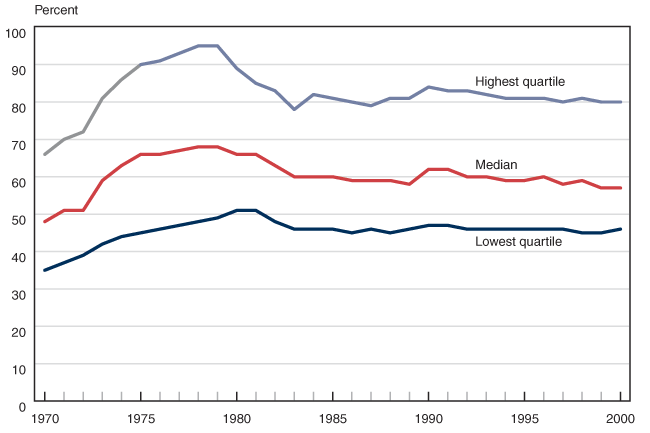
| Year | Lowest quartile | Median | Highest quartile |
|---|---|---|---|
| 1970 | 35 | 48 | 66 |
| 1971 | 37 | 51 | 70 |
| 1972 | 39 | 51 | 72 |
| 1973 | 42 | 59 | 81 |
| 1974 | 44 | 63 | 86 |
| 1975 | 45 | 66 | 90 |
| 1976 | 46 | 66 | 91 |
| 1977 | 47 | 67 | 93 |
| 1978 | 48 | 68 | 95 |
| 1979 | 49 | 68 | 95 |
| 1980 | 51 | 66 | 89 |
| 1981 | 51 | 66 | 85 |
| 1982 | 48 | 63 | 83 |
| 1983 | 46 | 60 | 78 |
| 1984 | 46 | 60 | 82 |
| 1985 | 46 | 60 | 81 |
| 1986 | 45 | 59 | 80 |
| 1987 | 46 | 59 | 79 |
| 1988 | 45 | 59 | 81 |
| 1989 | 46 | 58 | 81 |
| 1990 | 47 | 62 | 84 |
| 1991 | 47 | 62 | 83 |
| 1992 | 46 | 60 | 83 |
| 1993 | 46 | 60 | 82 |
| 1994 | 46 | 59 | 81 |
| 1995 | 46 | 59 | 81 |
| 1996 | 46 | 60 | 81 |
| 1997 | 46 | 58 | 80 |
| 1998 | 45 | 59 | 81 |
| 1999 | 45 | 57 | 80 |
| 2000 | 46 | 57 | 80 |
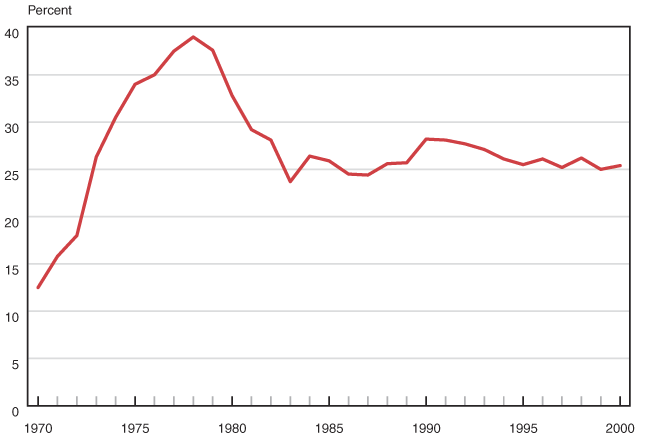
| Year | Percent |
|---|---|
| 1970 | 12.50 |
| 1971 | 15.80 |
| 1972 | 18.00 |
| 1973 | 26.30 |
| 1974 | 30.50 |
| 1975 | 34.00 |
| 1976 | 35.00 |
| 1977 | 37.50 |
| 1978 | 39.00 |
| 1979 | 37.60 |
| 1980 | 32.80 |
| 1981 | 29.20 |
| 1982 | 28.10 |
| 1983 | 23.70 |
| 1984 | 26.40 |
| 1985 | 25.90 |
| 1986 | 24.50 |
| 1987 | 24.40 |
| 1988 | 25.60 |
| 1989 | 25.70 |
| 1990 | 28.20 |
| 1991 | 28.10 |
| 1992 | 27.70 |
| 1993 | 27.10 |
| 1994 | 26.10 |
| 1995 | 25.50 |
| 1996 | 26.10 |
| 1997 | 25.20 |
| 1998 | 26.20 |
| 1999 | 25.00 |
| 2000 | 25.40 |
A better sense of the relationship between benefits and earnings is provided by examining replacement rates, which is the ratio of workers' DI benefits to predisability earnings. 1 This simple measure provides a glimpse of the adequacy, equity, and incentives associated with disability benefits.
Although there are many caveats related to taxes, multiple sources of disability income, and other factors, high replacement rates for DI benefits increase incentives for individuals to apply for benefits rather than to continue working. High replacement rates also reduce incentives to beneficiaries to return to self-supporting work. Replacement rates in the United States vary with workers' earnings histories and earnings levels, because the Social Security benefit formula is designed to replace a higher fraction of earnings for low earners than for high earners, thus giving low earners a higher replacement rate than that for high earners.
Charts 54 and 55 show trends of replacement rates for newly entitled DI beneficiaries from 1970 to 2000 that are based on a measure of actual lifetime earnings up to the year before the year of disability onset. The numerator is the amount of DI benefits paid to the worker and to any dependents.
As can be seen from these charts, replacement rates rose from the early to late 1970s, declined in the early 1980s, and have stabilized considerably since. The reduction in replacement rates resulted from Congressional action to stem the increase in replacement rates after the program experienced significant growth in the mid-1970s. Replacement rates began to rise dramatically after Congress passed automatic cost-of-living adjustments (COLAs) in 1972. The rise in replacement rates was partially the result of the method used to index benefits, which overcompensated new DI beneficiaries for the effects of inflation. In 1977, Congress enacted legislation intended to stabilize replacement rates by "decoupling" the COLA increase for current beneficiaries from the calculation of benefits for new beneficiaries. Current DI beneficiaries would receive COLA adjustments for price increases, and new beneficiaries would have their benefits based on wage-indexed earnings and on a benefit formula that was adjusted for increases in average wages. The new benefit calculation generally applied to disabled-worker beneficiaries becoming eligible in January 1979 and later. This legislation also froze the minimum benefit at its 1979 level.
In 1980, Congress took further action to limit replacement rates for disabled workers, targeting younger workers and those with dependents. That legislation made the formula for these workers less generous and placed caps on family benefits. In 1981, Congress eliminated the minimum benefit for all Social Security beneficiaries and placed an offset for multiple sources of public disability benefits (except veterans and means-tested programs) to ensure that replacement rates from all disability benefits would not be excessive. Replacement rates have not been a subject of controversy or legislation since that time.
Maximum SSI Payment Amount
The maximum federal SSI payment, known as the federal benefit rate, is fixed and indexed to the cost of living, and the real value does not change over time. Thus federal SSI payment amounts are stable and do not correlate with changes in applications for benefits and awards.
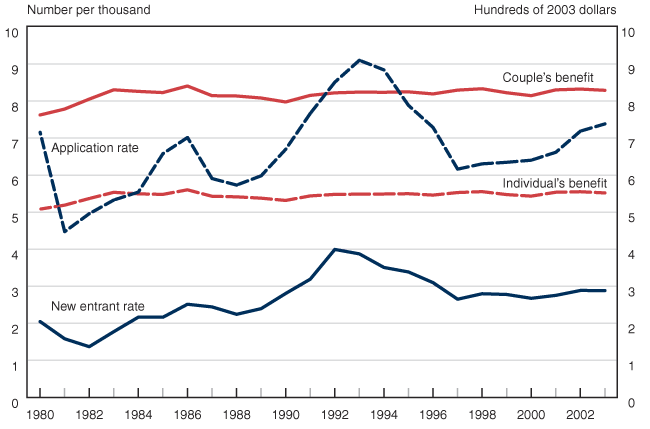
| Year | Benefits (2003 dollars) | Rates (number per thousand) | ||
|---|---|---|---|---|
| Individual | Couple | Application | New entrant | |
| 1980 | 5.08 | 7.62 | 7.17 | 2.06 |
| 1981 | 5.19 | 7.78 | 4.49 | 1.60 |
| 1982 | 5.37 | 8.05 | 4.98 | 1.39 |
| 1983 | 5.54 | 8.30 | 5.34 | 1.79 |
| 1984 | 5.50 | 8.26 | 5.56 | 2.18 |
| 1985 | 5.48 | 8.23 | 6.60 | 2.18 |
| 1986 | 5.60 | 8.41 | 7.03 | 2.53 |
| 1987 | 5.43 | 8.14 | 5.92 | 2.46 |
| 1988 | 5.41 | 8.14 | 5.75 | 2.26 |
| 1989 | 5.38 | 8.08 | 6.00 | 2.41 |
| 1990 | 5.32 | 7.98 | 6.71 | 2.82 |
| 1991 | 5.44 | 8.15 | 7.68 | 3.21 |
| 1992 | 5.48 | 8.22 | 8.53 | 4.01 |
| 1993 | 5.49 | 8.24 | 9.12 | 3.89 |
| 1994 | 5.49 | 8.24 | 8.86 | 3.52 |
| 1995 | 5.50 | 8.25 | 7.90 | 3.40 |
| 1996 | 5.46 | 8.19 | 7.30 | 3.11 |
| 1997 | 5.53 | 8.30 | 6.18 | 2.67 |
| 1998 | 5.55 | 8.33 | 6.32 | 2.81 |
| 1999 | 5.48 | 8.22 | 6.36 | 2.79 |
| 2000 | 5.43 | 8.15 | 6.42 | 2.69 |
| 2001 | 5.54 | 8.30 | 6.63 | 2.77 |
| 2002 | 5.55 | 8.32 | 7.20 | 2.90 |
| 2003 | 5.52 | 8.29 | 7.40 | 2.90 |
Many SSI recipients have limited or no earnings history, so replacement rates are not as relevant a measure for the SSI program. Less than one-quarter of recipients had sufficient work experience to qualify for even a small Social Security benefit. Furthermore, the federal benefit amount for SSI is relatively static over time, as the benefit is indexed to inflation. Chart 56 illustrates that the inflation-adjusted benefits are fairly stable over time, and changes in applications and awards of SSI payments do not correlate with benefit amounts. The periods of growth and contraction in applications and awards seem to follow patterns similar to those observed for the DI program. The patterns seem to have some correlation with economic and policy changes, but the precise relationship is not known.
One other factor may contribute to incentives to seek SSI payments: the income and resource test. SSI limits the amount of assets, earned income, and unearned income the individual may have and still qualify for benefits. The asset limit ($2,000) has not been increased since 1984, and the disregards for earned and unearned income ($65 and $20 per month, respectively) have not been changed since the program began. The effect that inflation has had on the real level of these tests may have served to tighten eligibility criteria, although spend-down provisions, under which individuals must divest themselves of assets to qualify for SSI, may have lessened the impact of the asset test.
Changes in Substantial Gainful Activity Level
For long periods, the monthly level of substantial gainful activity for the nonblind, in nominal dollars, did not change. Since 2001, the level automatically increases as a consequence of changes in the wage index.
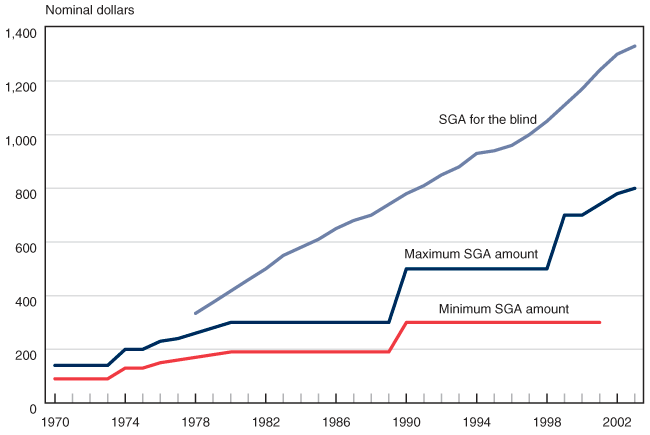
| Year | Maximum SGA amount | Minimum SGA amount | SGA for the blind |
|---|---|---|---|
| 1970 | 140 | 90 | . . . |
| 1971 | 140 | 90 | . . . |
| 1972 | 140 | 90 | . . . |
| 1973 | 140 | 90 | . . . |
| 1974 | 200 | 130 | . . . |
| 1975 | 200 | 130 | . . . |
| 1976 | 230 | 150 | . . . |
| 1977 | 240 | 160 | . . . |
| 1978 | 260 | 170 | 334 |
| 1979 | 280 | 180 | 375 |
| 1980 | 300 | 190 | 417 |
| 1981 | 300 | 190 | 459 |
| 1982 | 300 | 190 | 500 |
| 1983 | 300 | 190 | 550 |
| 1984 | 300 | 190 | 580 |
| 1985 | 300 | 190 | 610 |
| 1986 | 300 | 190 | 650 |
| 1987 | 300 | 190 | 680 |
| 1988 | 300 | 190 | 700 |
| 1989 | 300 | 190 | 740 |
| 1990 | 500 | 300 | 780 |
| 1991 | 500 | 300 | 810 |
| 1992 | 500 | 300 | 850 |
| 1993 | 500 | 300 | 880 |
| 1994 | 500 | 300 | 930 |
| 1995 | 500 | 300 | 940 |
| 1996 | 500 | 300 | 960 |
| 1997 | 500 | 300 | 1,000 |
| 1998 | 500 | 300 | 1,050 |
| 1999 | 700 | 300 | 1,110 |
| 2000 | 700 | 300 | 1,170 |
| 2001 | 740 | 300 | 1,240 |
| 2002 | 780 | . . . | 1,300 |
| 2003 | 800 | . . . | 1,330 |
| NOTE: . . . = not applicable. | |||
The level of substantial gainful activity (SGA) has long been established by regulation. Before 2002, there was a maximum and minimum SGA amount. Monthly earnings (minus impairment-related work expenses) that fell below the minimum SGA amount were not considered to constitute SGA. Monthly earnings between the maximum and minimum SGA amounts required that consideration be given to all circumstances related to work activities to determine whether the work activity was SGA. Work activity that resulted in monthly earnings that were above the maximum SGA amount was automatically determined to be SGA. Beginning in 1978, the SGA level for the blind was tied to the early retirement test exempt amount and has thus been automatically adjusted for changes in the average wage. Until 2001, the SGA level for the nonblind had been subject to ad hoc increases as determined to be appropriate by the Commissioner of Social Security, with the last two ad hoc increases occurring in 1990 and 1999. Since 2001, the SGA level for the nonblind has also been subjected to automatic adjustments for changes in the wage series, albeit at a lower absolute level than that established for the blind. For 2006, the monthly SGA amount is $1,450 for statutorily blind individuals and $860 for nonblind individuals.
Substantial Gainful Activity Level and Application Rates
Changes in the real (price-adjusted) SGA level for nonblind individuals suggests that increasing the real value of substantial gainful activity may influence the application rates for the DI and SSI programs.
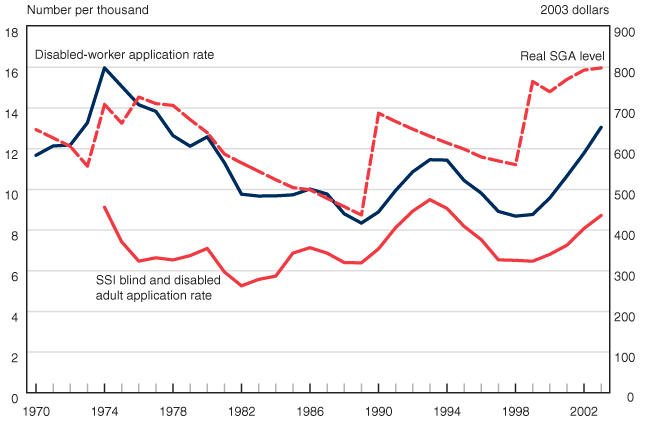
| Year | Disabled-worker application rate (number per thousand) |
SSI blind and disabled adult application rate (number per thousand) |
Real SGA level (2003 dollars) |
|---|---|---|---|
| 1970 | 11.67 | . . . | 648.29 |
| 1971 | 12.13 | . . . | 627.79 |
| 1972 | 12.18 | . . . | 607.11 |
| 1973 | 13.27 | . . . | 558.48 |
| 1974 | 15.97 | 9.12 | 710.21 |
| 1975 | 15.07 | 7.42 | 664.14 |
| 1976 | 14.16 | 6.47 | 728.33 |
| 1977 | 13.83 | 6.64 | 712.27 |
| 1978 | 12.64 | 6.53 | 707.80 |
| 1979 | 12.12 | 6.74 | 672.80 |
| 1980 | 12.58 | 7.10 | 640.67 |
| 1981 | 11.31 | 5.94 | 588.19 |
| 1982 | 9.76 | 5.26 | 566.50 |
| 1983 | 9.67 | 5.57 | 545.80 |
| 1984 | 9.68 | 5.74 | 525.07 |
| 1985 | 9.73 | 6.87 | 505.86 |
| 1986 | 10.02 | 7.13 | 500.36 |
| 1987 | 9.77 | 6.86 | 479.12 |
| 1988 | 8.80 | 6.40 | 458.84 |
| 1989 | 8.34 | 6.39 | 438.46 |
| 1990 | 8.89 | 7.07 | 688.71 |
| 1991 | 9.95 | 8.12 | 668.24 |
| 1992 | 10.86 | 8.93 | 649.40 |
| 1993 | 11.46 | 9.49 | 632.03 |
| 1994 | 11.44 | 9.06 | 615.56 |
| 1995 | 10.43 | 8.18 | 600.33 |
| 1996 | 9.82 | 7.53 | 581.02 |
| 1997 | 8.92 | 6.54 | 571.30 |
| 1998 | 8.68 | 6.51 | 562.23 |
| 1999 | 8.76 | 6.47 | 766.55 |
| 2000 | 9.57 | 6.80 | 741.44 |
| 2001 | 10.65 | 7.25 | 771.83 |
| 2002 | 11.78 | 8.08 | 794.66 |
| 2003 | 13.05 | 8.72 | 800.00 |
| . . . = not applicable. | |||
The changes in the real (price-adjusted) SGA level for nonblind individuals during the period 1970 to 2003, along with trends in the rate of applications for disabled-worker benefits and SSI disabled adult benefits (aged 18–64), suggest that increasing the real value of SGA may influence the application rates for both programs. However, the policy decisions to raise the SGA level in 1990 and in 1999 came at peaks in the economic cycle, just as the economy was tilting toward recession, and it is difficult to determine the extent to which the change in SGA influenced applications or to what extent the tightening labor market did.
Unemployment Rate and Application and Incidence Rates for Disabled Workers
Disabled-worker application rates and incidence rates have tended to rise in periods of increasing unemployment and fall in periods of decreasing unemployment with the exception of the early 1980s, when the program was tightened and the benefits were reduced.
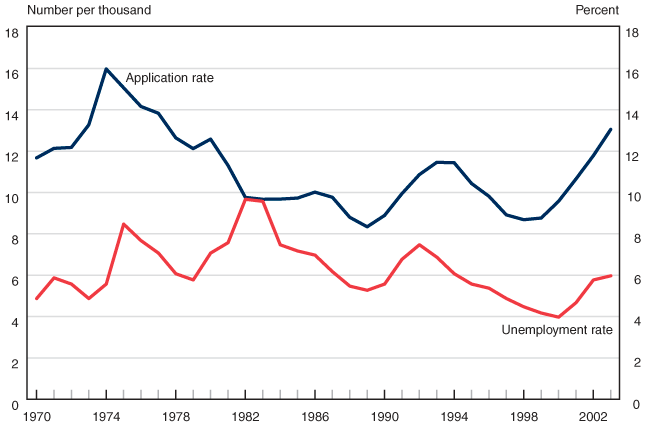
| Year | Application rate (number per thousand) | Unemployment rate (percent) |
|---|---|---|
| 1970 | 11.67 | 4.90 |
| 1971 | 12.13 | 5.90 |
| 1972 | 12.18 | 5.60 |
| 1973 | 13.27 | 4.90 |
| 1974 | 15.97 | 5.60 |
| 1975 | 15.07 | 8.50 |
| 1976 | 14.16 | 7.70 |
| 1977 | 13.83 | 7.10 |
| 1978 | 12.64 | 6.10 |
| 1979 | 12.12 | 5.80 |
| 1980 | 12.58 | 7.10 |
| 1981 | 11.31 | 7.60 |
| 1982 | 9.76 | 9.70 |
| 1983 | 9.67 | 9.60 |
| 1984 | 9.68 | 7.50 |
| 1985 | 9.73 | 7.20 |
| 1986 | 10.02 | 7.00 |
| 1987 | 9.77 | 6.20 |
| 1988 | 8.80 | 5.50 |
| 1989 | 8.34 | 5.30 |
| 1990 | 8.89 | 5.60 |
| 1991 | 9.95 | 6.80 |
| 1992 | 10.86 | 7.50 |
| 1993 | 11.46 | 6.90 |
| 1994 | 11.44 | 6.10 |
| 1995 | 10.43 | 5.60 |
| 1996 | 9.82 | 5.40 |
| 1997 | 8.92 | 4.90 |
| 1998 | 8.68 | 4.50 |
| 1999 | 8.76 | 4.20 |
| 2000 | 9.57 | 4.00 |
| 2001 | 10.65 | 4.70 |
| 2002 | 11.78 | 5.80 |
| 2003 | 13.05 | 6.00 |
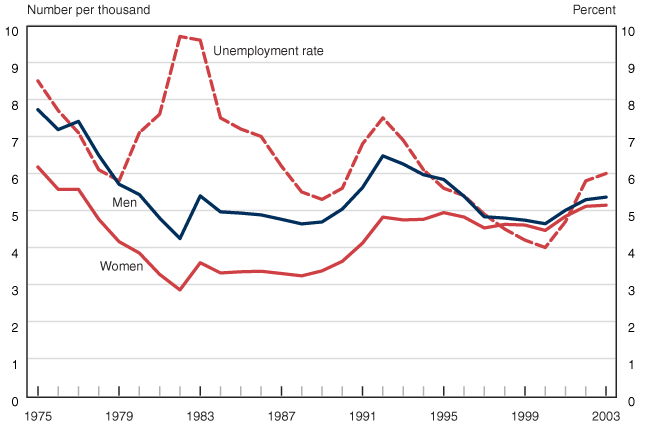
| Year | Men | Women | Unemployment rate |
|---|---|---|---|
| 1975 | 7.72 | 6.18 | 8.50 |
| 1976 | 7.19 | 5.57 | 7.70 |
| 1977 | 7.41 | 5.57 | 7.10 |
| 1978 | 6.49 | 4.76 | 6.10 |
| 1979 | 5.71 | 4.16 | 5.80 |
| 1980 | 5.43 | 3.85 | 7.10 |
| 1981 | 4.80 | 3.28 | 7.60 |
| 1982 | 4.24 | 2.86 | 9.70 |
| 1983 | 5.39 | 3.59 | 9.60 |
| 1984 | 4.96 | 3.31 | 7.50 |
| 1985 | 4.93 | 3.35 | 7.20 |
| 1986 | 4.88 | 3.36 | 7.00 |
| 1987 | 4.76 | 3.30 | 6.20 |
| 1988 | 4.64 | 3.24 | 5.50 |
| 1989 | 4.69 | 3.37 | 5.30 |
| 1990 | 5.04 | 3.63 | 5.60 |
| 1991 | 5.62 | 4.12 | 6.80 |
| 1992 | 6.48 | 4.82 | 7.50 |
| 1993 | 6.26 | 4.75 | 6.90 |
| 1994 | 5.97 | 4.76 | 6.10 |
| 1995 | 5.84 | 4.94 | 5.60 |
| 1996 | 5.38 | 4.82 | 5.40 |
| 1997 | 4.83 | 4.53 | 4.90 |
| 1998 | 4.80 | 4.63 | 4.50 |
| 1999 | 4.74 | 4.61 | 4.20 |
| 2000 | 4.64 | 4.46 | 4.00 |
| 2001 | 5.01 | 4.84 | 4.70 |
| 2002 | 5.29 | 5.11 | 5.80 |
| 2003 | 5.36 | 5.14 | 6.00 |
Economic changes influence applications to the DI and SSI programs. Historically, when unemployment rises, applications and awards for the DI program have increased as well. Disabled-worker application rates have tended to rise in periods of increasing unemployment and fall in periods of decreasing unemployment, with the notable exception of the early 1980s, when unemployment approached 10 percent and the rate of applications declined dramatically (Chart 59). However, at the same time, a tightening of the program and reductions in benefits were taking place and may have had a greater influence that resulted in declining application rates. The incidence rate for DI workers (awards per 1,000 in the disability-insured population) also tends to follow the unemployment rate (and application rate), with the same caveat about the period of the early 1980s (Chart 60).
Economic factors in addition to the unemployment rate may also influence applications, awards, and the size of the DI program. These factors could include changes in the wage distribution and changes in the occupational structure of the economy, as well as a multitude of other factors. Quantifying such changes is difficult and beyond the scope of this book; however, it is clear that the distribution of income and wages has widened and that low-income workers are falling behind higher-income workers.2 The occupational structure in the United States has moved away from manufacturing and toward service jobs, which has an indeterminate effect on applications and awards. Although service jobs tend to be less physically demanding, the mental and cognitive requirements are greater.
Unemployment Rate, SGA, and Application Rates for Disabled Workers
Although the application rate seems to follow the same trends as changes in real substantial gainful activity level (in 2003 dollars) and the unemployment rate, it is difficult to determine the factors that affect growth and to disentangle the effects of those factors.
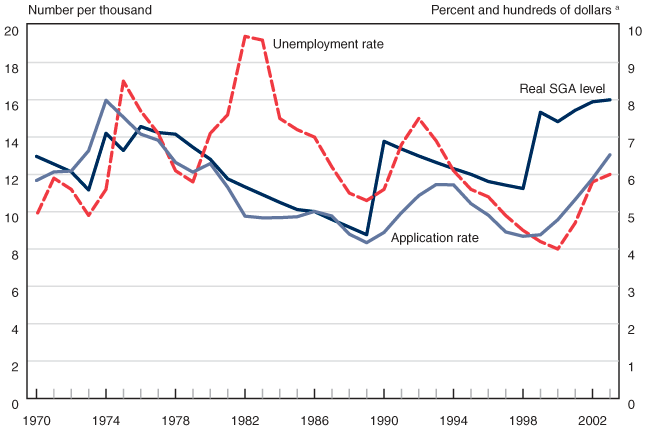
| Year | Application rate | Real SGA level | Unemployment rate |
|---|---|---|---|
| 1970 | 11.67 | 6.48 | 4.90 |
| 1971 | 12.13 | 6.28 | 5.90 |
| 1972 | 12.18 | 6.07 | 5.60 |
| 1973 | 13.27 | 5.58 | 4.90 |
| 1974 | 15.97 | 7.10 | 5.60 |
| 1975 | 15.07 | 6.64 | 8.50 |
| 1976 | 14.16 | 7.28 | 7.70 |
| 1977 | 13.83 | 7.12 | 7.10 |
| 1978 | 12.64 | 7.08 | 6.10 |
| 1979 | 12.12 | 6.73 | 5.80 |
| 1980 | 12.58 | 6.41 | 7.10 |
| 1981 | 11.31 | 5.88 | 7.60 |
| 1982 | 9.76 | 5.66 | 9.70 |
| 1983 | 9.67 | 5.46 | 9.60 |
| 1984 | 9.68 | 5.25 | 7.50 |
| 1985 | 9.73 | 5.06 | 7.20 |
| 1986 | 10.02 | 5.00 | 7.00 |
| 1987 | 9.77 | 4.79 | 6.20 |
| 1988 | 8.80 | 4.59 | 5.50 |
| 1989 | 8.34 | 4.38 | 5.30 |
| 1990 | 8.89 | 6.89 | 5.60 |
| 1991 | 9.95 | 6.68 | 6.80 |
| 1992 | 10.86 | 6.49 | 7.50 |
| 1993 | 11.46 | 6.32 | 6.90 |
| 1994 | 11.44 | 6.16 | 6.10 |
| 1995 | 10.43 | 6.00 | 5.60 |
| 1996 | 9.82 | 5.81 | 5.40 |
| 1997 | 8.92 | 5.71 | 4.90 |
| 1998 | 8.68 | 5.62 | 4.50 |
| 1999 | 8.76 | 7.67 | 4.20 |
| 2000 | 9.57 | 7.41 | 4.00 |
| 2001 | 10.65 | 7.72 | 4.70 |
| 2002 | 11.78 | 7.95 | 5.80 |
| 2003 | 13.05 | 8.00 | 6.00 |
This chart shows the application rate for disabled-worker benefits along with the unemployment rate (an external factor) and the level of substantial gainful activity in constant dollars (an internal factor). It is interesting that the unemployment rate and the real SGA level follow similar trends, perhaps because, in the past, SGA levels received ad hoc increases near the peak in the economic cycle. Although these data are suggestive of relationships, it is difficult to determine the factors that affect growth and to disentangle the effects of those factors.
Unemployment Rate and SSI Application and Incidence Rates for Adults (18–64)
Because of the limited work history of SSI applicants, one might not expect their rates of applications and new entrants to follow unemployment rates in the same pattern as the rates for DI applicants, who have a substantial work history. The patterns, however, are quite similar.
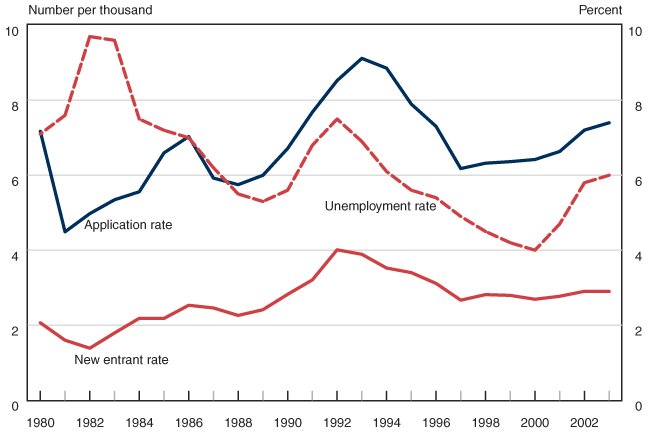
| Year | Unemployment rate | Application rate | New entrant rate |
|---|---|---|---|
| 1980 | 7.10 | 7.17 | 2.06 |
| 1981 | 7.60 | 4.49 | 1.60 |
| 1982 | 9.70 | 4.98 | 1.39 |
| 1983 | 9.60 | 5.34 | 1.79 |
| 1984 | 7.50 | 5.56 | 2.18 |
| 1985 | 7.20 | 6.60 | 2.18 |
| 1986 | 7.00 | 7.03 | 2.53 |
| 1987 | 6.20 | 5.92 | 2.46 |
| 1988 | 5.50 | 5.75 | 2.26 |
| 1989 | 5.30 | 6.00 | 2.41 |
| 1990 | 5.60 | 6.71 | 2.82 |
| 1991 | 6.80 | 7.68 | 3.21 |
| 1992 | 7.50 | 8.53 | 4.01 |
| 1993 | 6.90 | 9.12 | 3.89 |
| 1994 | 6.10 | 8.86 | 3.52 |
| 1995 | 5.60 | 7.90 | 3.40 |
| 1996 | 5.40 | 7.30 | 3.11 |
| 1997 | 4.90 | 6.18 | 2.67 |
| 1998 | 4.50 | 6.32 | 2.81 |
| 1999 | 4.20 | 6.36 | 2.79 |
| 2000 | 4.00 | 6.42 | 2.69 |
| 2001 | 4.70 | 6.63 | 2.77 |
| 2002 | 5.80 | 7.20 | 2.90 |
| 2003 | 6.00 | 7.40 | 2.90 |
The SSI program tends to serve persons with no, or very limited, work history. As demonstrated in Chart 13, the proportion of SSI recipients who concurrently receive a DI worker's benefit increased from 16 percent in 1981 to about 20 percent in 1993 and has remained near that level ever since. This would seem to suggest that the SSI program would be less influenced by economic conditions than would the DI worker program. The application rate of disabled adults and the rate of new entrants to the SSI program follow a pattern similar to that of DI workers, with rates of applications and incidence tracking the unemployment rate after the mid-1980s, but not in the early 1980s.
Notes
1. The measure of predisability earnings used in the computation of replacement rates was average indexed monthly earnings, which is basically the same formula used by SSA since 1980 to computer benefits. Earnings are indexed by average wages for each year and, depending on age, up to 5 years of lowest earnings after the age of 22 are dropped from the calculation.
2. See, for example, Arthur F. Jones, Jr., and Daniel H. Weinberg, The Changing Shape of the Nation's Income Distribution, 1947–1988, Current Population Reports P60-204 (Washington, DC: Census Bureau, 2000), which shows a generally consistent pattern of a widening of the earnings distribution from 1981 to 1998.